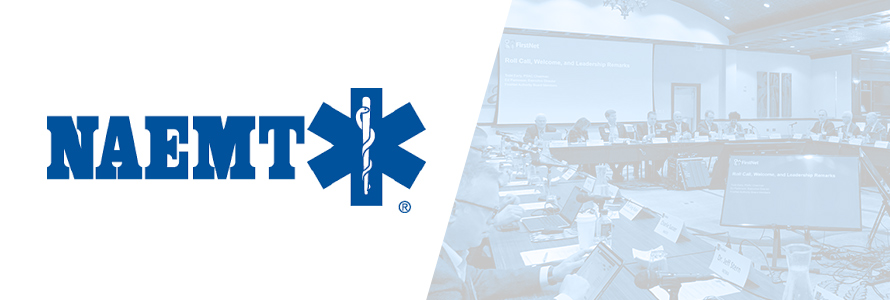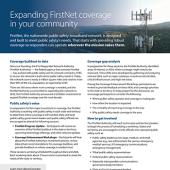This is the latest in a blog series highlighting the associations of the First Responder Network Authority’s (FirstNet Authority’s) Public Safety Advisory Committee (PSAC). PSAC members represent associations and agencies from all public safety disciplines, as well as state, territorial, tribal, and local governments. Together, they provide guidance and recommendations to the FirstNet Authority in carrying out its duties and responsibilities. The PSAC’s input is invaluable to the development of FirstNet, the nationwide broadband network dedicated to public safety.
Founded in 1975, the National Association of Emergency Medical Technicians (NAEMT) is a national association representing all EMS practitioners, including paramedics, EMTs, and other emergency response personnel. With over 72,000 members from all sectors of EMS, NAEMT promotes the important work of EMS practitioners to federal and state government officials. In addition, the association supports EMS research and innovations, advocates for efforts to improve patient care, and sponsors educational programs for EMS practitioners.
Chief Brian Schaeffer serves as the fire chief for the Spokane Fire Department in Washington, as well as NAEMT’s representative on the Public Safety Advisory Committee (PSAC). He understands the critical role broadband communications plays in the work of EMS professionals.
“Timely, reliable, and accessible information is critical for patient care and the protection of pre-hospital healthcare responders in the United States. Brick and mortar healthcare systems have enjoyed the benefit of internal high-speed networks capable of sharing critical information with providers throughout their system for years. The pre-hospital providers’ access to that information, however, has been limited due to bandwidth, mobile security concerns and access—until now. The FirstNet network allows access to high-speed data, secured by the best cybersecurity available. FirstNet is the first and only true technology platform that has proven to be a point of leverage for us to help improve care to the community and the safety of our people.” said Chief Schaeffer.
Advancing telehealth capabilities
Increasingly, medical professionals are turning to telehealth to meet with patients. Telehealth enables patients to receive enhanced care more rapidly, easily, and safely. It also helps EMS practitioners manage the more than 40 million annual calls for EMS care, reducing the number of ambulance transports and providing faster care for non-urgent incidents.
Reliable, secure broadband is a necessity for telehealth. With FirstNet, subscribers benefit from a dedicated core network that separates public safety traffic and data sharing from commercial users. Subscribers also experience the advantages that come with priority and preemption, ensuring they stay connected even when networks are congested. While FirstNet offers many capabilities that are essential to successful telehealth sessions, the PSAC recognized the critical role the network can play in further advancing telehealth capabilities. As a result, the PSAC stood up a telehealth strike team in 2019 to address the topic in depth.
Chief Schaeffer served on the strike team, ensuring the voice of our nation’s EMS community was heard. “Although pre-hospital medicine is only a sliver of the nation’s healthcare system, it serves as a lynchpin to access lifesaving care for everyone. It is critical for the NAEMT and our members that the network’s coverage and broadband capabilities continue to improve as planned,” said Chief Schaeffer.
Building a network for EMTs
In addition to telehealth, the NAEMT works with the PSAC and the FirstNet Authority to bring attention to the work of our EMS practitioners and their operational needs. This feedback has been used to shape the FirstNet Authority Roadmap, the guide to the network’s growth and evolution.
Developed through hundreds of engagements with public safety stakeholders and PSAC members like NAEMT, the Roadmap is structured around six domains: the core, situational awareness, secure information exchange, coverage and capacity, voice communications, and user experience. These domains represent the network capabilities that are essential to the public safety community.
EMS has a demonstrated need for technologies that enable them to quickly send advanced diagnostic information and implement advanced treatment modalities. FirstNet capabilities like the user experience domain will enable EMS practitioners to access key technologies like up-to-date applications, devices, priority services, and augmented or virtual reality to connect with hospitals to provide faster and better treatment to patients in a pre-hospital setting.
Through continued conversations with the NAEMT and other members within the EMS community, the FirstNet Authority is working to make address these needs. Their feedback remains critical to the continued evolution of FirstNet.
To learn more about the NAEMT, visit https://www.naemt.org/ or engage with the association on Facebook, Instagram, Twitter, and YouTube.
Interested in learning more about the FirstNet Authority or the PSAC? Visit our website at FirstNet.gov.




















